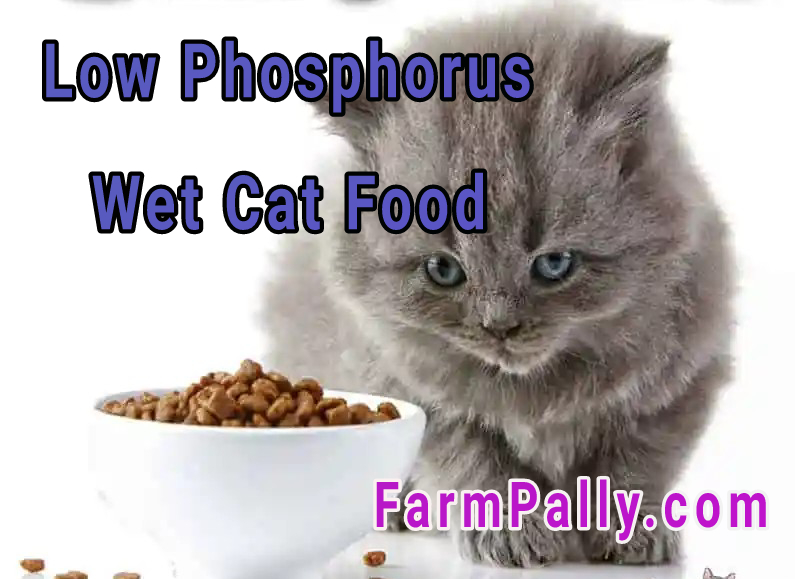Why should Phosphorus be lowered in a Cat’s food?
Cats tend to eat poisonous substances more than their close rival, dogs. This explains the reason cats often get kidney disease.
Also, they need a small level of phosphorus in their diet, and a high level of it can worsen kidney damage.
Excess dietary phosphorus results in higher serum phosphate, which stimulates PTH and FGF-23, which is tied to faster progression of chronic kidney disease (CKD) in cats.
Therefore, the key ingredient cats with kidney disease should avoid is phosphorus.
Lowering dietary phosphorus is a smart way to slow kidney disease in cats, and a cornerstone of nutritional management for cats with IRIS-stage kidney disease.
What is considered a low phosphorus level in cat food?
When your veterinarian advises you to switch to low-phosphorus cat food for cats with Acute Kidney Disease (AKD) or Chronic Kidney Disease (CKD), what does it mean?
They usually recommend cat food with between 0.3 – 0.6% phosphorus on a dry-matter basis for therapeutic kidney diets. It’s rare to have food with a ~0.3% phosphorus level unless it’s a supplemental food.
However, wet cat food is more suitable for cats with kidney issues, so how do you compare as-fed phosphorus on a can with the dry-matter (DM) with wet food?
The formula – Phosphorus (DM%) = Phosphorus (as-fed %) ÷ (1 − moisture fraction).
Let’s use Royal Canin Renal Support E for example, moisture = 79.5%. The Dry-Matter fraction = 1 − 0.795 = 0.205.
If the label lists phosphorus ≈0.14% as-fed, then 0.14 ÷ 0.205 = 0.6829% phosphorus Level in wet food, and ~0.68% phosphorus Level in dry food.
Doing this conversion yourself is important since most low phosphorus targets for CKD are given on a dry-matter basis, usually between 0.3 – 0.6% DM.
Best Low Phosphorus Wet Cat Foods
If you confirm these symptoms are triggered by high phosphorus – weight loss, poor appetite, dental problems, vomiting, and nausea, you should lower it quickly.
The following are both prescription and non-low-phosphorus wet cat foods that are good for cats with kidney disease.
Hill’s Prescription Diet k/d (wet pâté)
This is a veterinary therapeutic renal diet specifically formulated for cats with CKD.
The phosphorus level is around 0.5% on a dry-matter basis for some k/d wet formulas, which makes it fall in the renal target range.
Vets commonly prescribe wet pâté for IRIS stage ≥2.
Being a prescription therapeutic food for KD, it includes other renal-support ingredients such as lower sodium, controlled protein quality, added B vitamins and omega-3s).
Purina Pro Plan Veterinary Diets NF (wet)
Purina’s NF (kidney) wet formulations list low as-fed phosphorus.
For example, ~0.12% as-fed on some products with moisture near 77%, which converts to roughly 0.52% phosphorus on a dry-matter basis (0.12 ÷ 0.23 ≈ 0.5217%).
That DM phosphorus places NF inside the commonly recommended 0.3–0.6% window; as a prescription diet, it’s formulated to be complete and to include other renal-friendly nutrient adjustments.
Royal Canin Veterinary Diet Renal Support E (Loaf in sauce)
Royal Canin’s average phosphorus level is 0.50%, while Renal Support wet line has phosphorus around 0.14 to 0.15% as-fed and a moisture of ~79.5%.
Using my formula above, that yields roughly 0.68% phosphorus DM (0.14 ÷ 0.205 ≈ 0.6829), which is higher than some renal targets.
This has prompted confusion in cat communities about interpreting as-fed numbers and recipe changes.
It is important to check the exact guaranteed analysis for the specific Royal Canin wet variety you plan to use and discuss with your vet whether that variety fits your cat’s IRIS stage and lab results.
Blue Buffalo Natural Veterinary Diet K+M (kidney + mobility)
Blue’s K+M is a veterinary-prescribed “kidney support” line as well.
It has low phosphorus when measured as-fed (for some batches shown as low as 0.08% up to 0.20% as-fed).
With moisture around 78%; that converts to a DM phosphorus range roughly 0.36% (0.08 ÷ 0.22 ≈ 0.3636) up to about 0.91% DM at the higher end (0.20 ÷ 0.22 ≈ 0.909).
Weruva Wx Phos Focused line – non-prescription option (supplemental use)
Weruva’s Wx Phos Focused line is explicitly formulated to be “lower” in naturally occurring phosphorus.
Weruva Wx Tilapia & Tuna puree, Weruva Wx chicken & tilapia in gravy contain up to less phosphorus than AAFCO minimums.
There are also several Wx products designed for supplemental feeding.
For example, Wx Tilapia & Chicken Purée phosphorus ≈0.053% as-fed and ~0.28% DM – this is below the common 0.3% DM floor used for many therapeutic diets.
This is the reason we recommend Weruva as a non-prescription supplemental, low-phos topper.
Tiki Cat (Silver and Veterinary lines) – variable and batch-sensitive
Tiki Cat has senior and veterinary-targeted lines that have been reviewed as having comparatively low phosphorus in some recipes.
It was reported that Velvet Mousse reports phosphorus values in manufacturer notes and some batches of Silver senior recipes list phosphorus around 0.14% as-fed).
When converted to DM, that can be ~0.7% DM if moisture is 80% (0.14 ÷ 0.20 = 0.70), so batch and variety matter.
Conclusion
If your cat has IRIS-stage CKD, stage 2 or higher, your cat’s doctor would likely recommend veterinary renal diets.
Those foods are not just low in phosphorus but also have balanced protein quality, sodium, omega-3s, vitamins and calories.
All these are important for appetite and lean-mass preservation, and those diets are complete and balanced, not supplemental.
Non-prescription foods may have calorie density and palatability issues which may lead to calorie shortfall, weight and muscle loss in CKD cats.
If your cats reject prescription foods, and you want to offer non-prescription lines, check the guaranteed analysis for phosphorus and moisture to determine whether it’s complete and balanced, or requires supplementation.
Both phosphorus control and overall nutrient adequacy should be balanced in CKD cats’ management.
Your cat doctor is not only concerned about dietary phosphorus, but he will interpret bloodwork, urine tests, appetite, weight, and overall condition before recommending a particular food or a phosphate binder.
